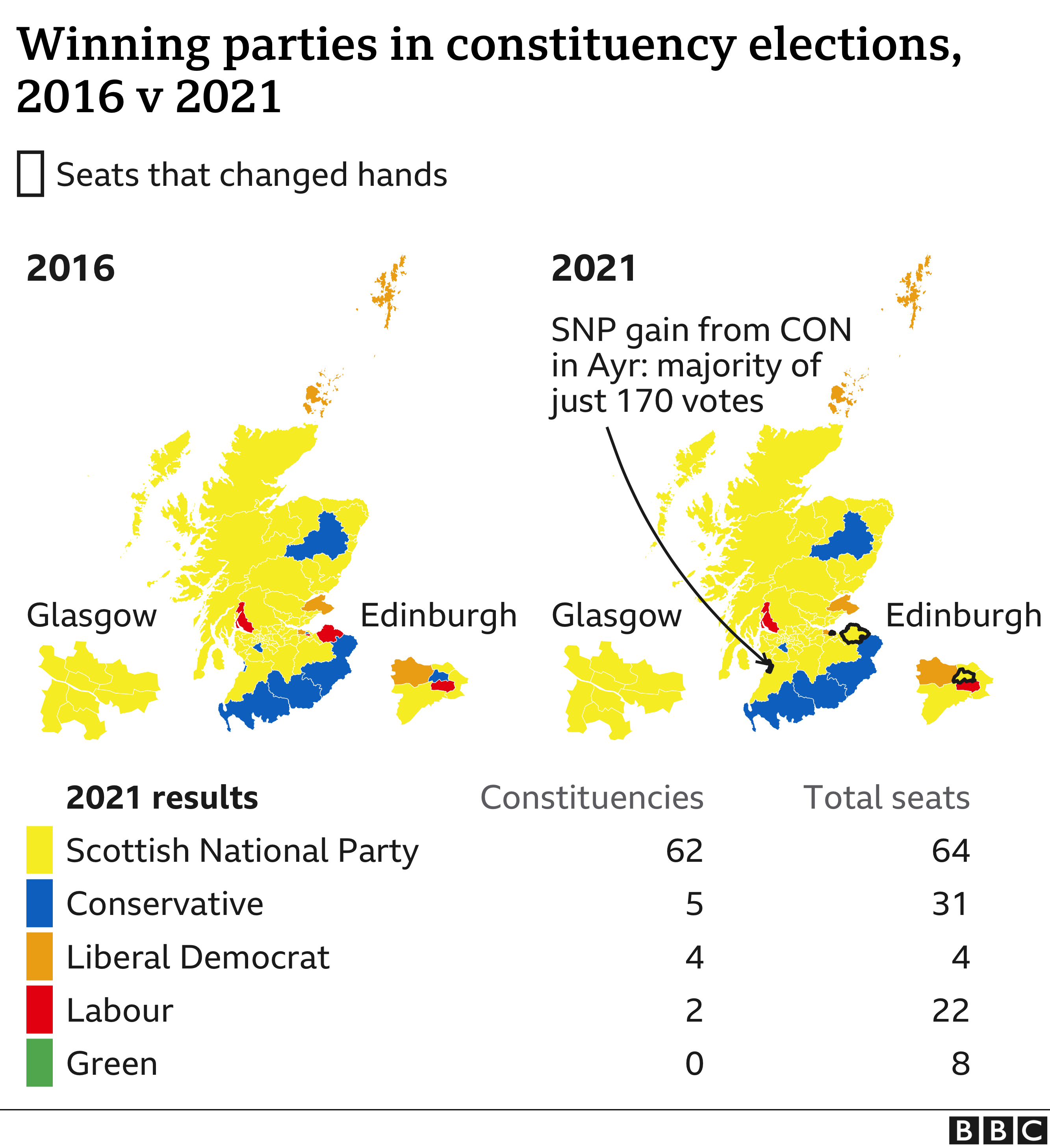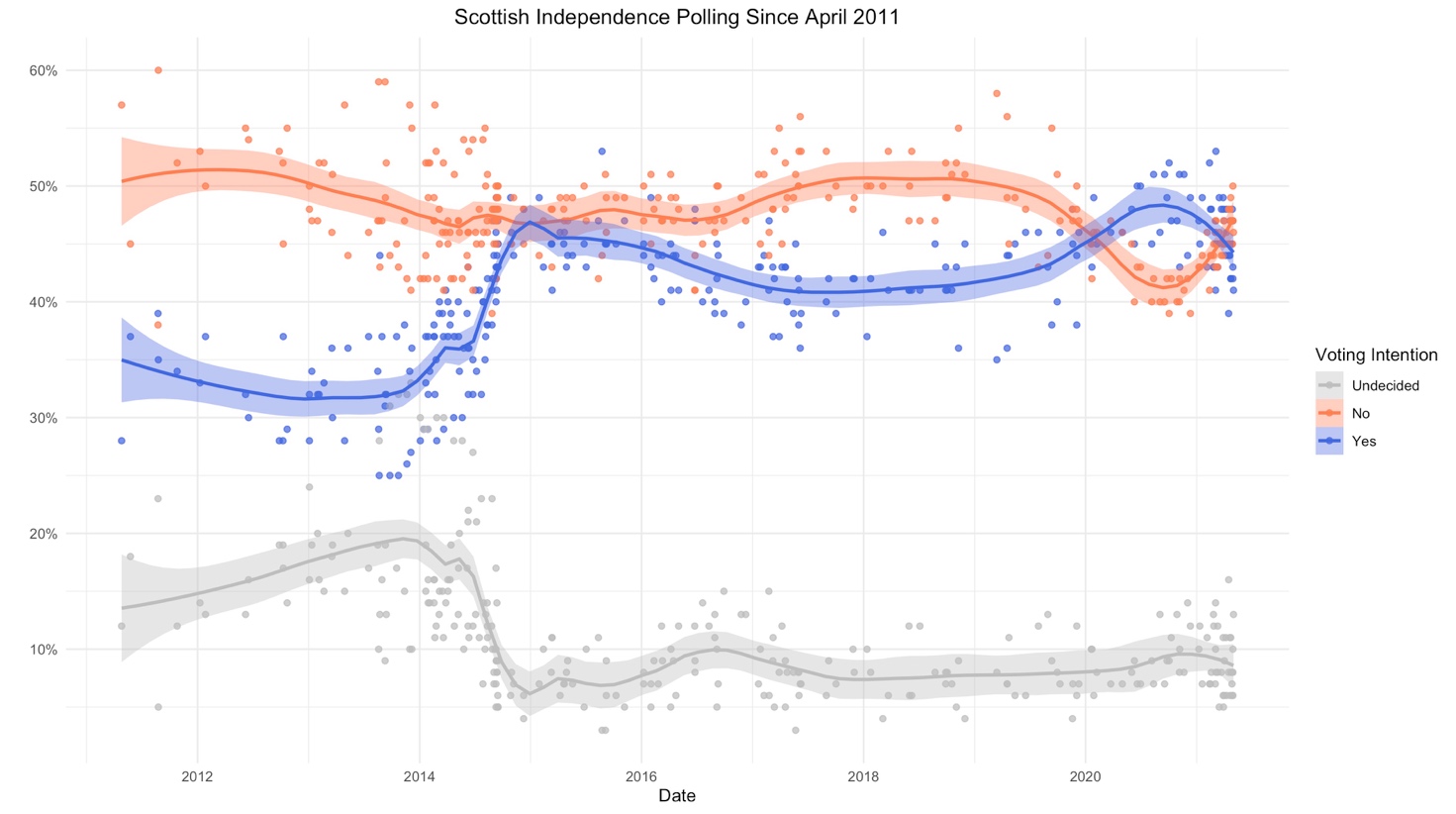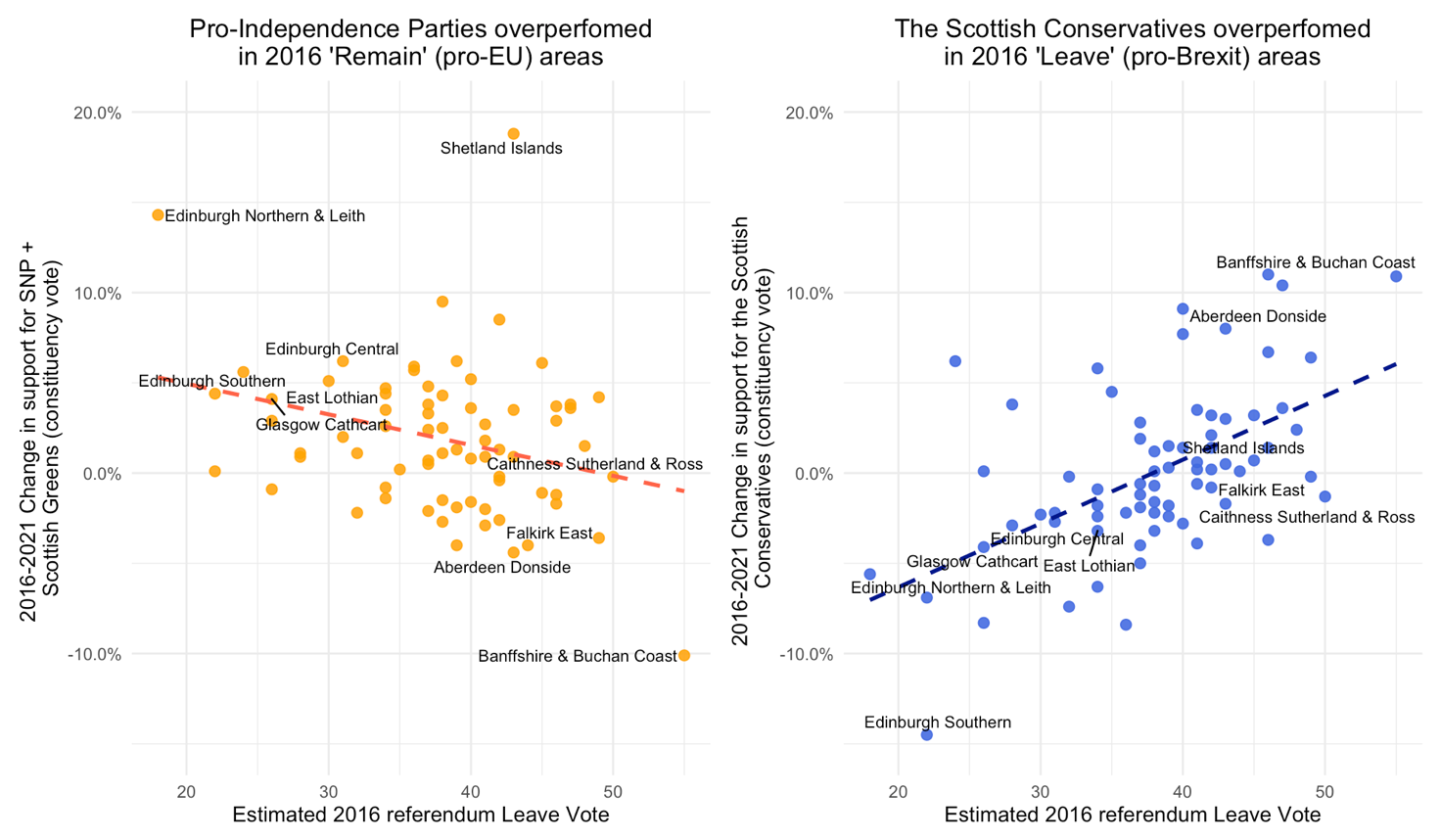The pro-independence majority in the Scottish Parliament: a slow-motion confrontation with London
On May 6, 2021, voters in Scotland’s parliamentary election delivered a majority for parties that advocate the country’s independence from the United Kingdom. While the balance of power in Holyrood – the seat of the Scottish parliament in Edinburgh – has barely budged since the last election in 2016, the result is likely to put an independence referendum back on the agenda.
The institutional clash between Holyrood, which now claims a democratic mandate for holding a new vote on independence, and Westminster, which can wield the force of law to prevent it, is set to define the post-pandemic (and post-Brexit) politics of a nation evenly split on its constitutional future.

The result
The main political force behind the independence movement, Nicola Sturgeon’s Scottish National Party (SNP), secured 64 out of 129 seats: one up from the party’s result in May 2016, but still one short of a single-party majority. Nonetheless, Sturgeon can rely on the eight MPs of the Scottish Green Party, which also supports a referendum and Scottish independence, to continue governing the devolved administration for the next five years. Her government will most likely be an SNP-led minority administration with Green parliamentary support, though a closer partnership in the form of a coalition cabinet has not been ruled out. It would be Sturgeon’s second full term as Scotland’s first minister and the SNP’s fourth term in government, as well as the largest ever pro-independence majority in parliament, totaling 72 seats. Pro-union parties notched up only 57 seats: 31 for the Scottish Conservatives, 22 for Scottish Labour and four for the Scottish Liberal Democrats.
The aggregate picture is one of remarkable, uncanny stability: Every party is within two seats and two percentage points of where it was five years ago. This is all the more impressive given that since the last Holyrood election, Scots voted to stay in the EU, left the EU, changed three UK prime ministers, took part in two Westminster elections, experienced a deadly disease outbreak and one of the most successful public health campaigns in history, saw Scotland’s former first minister tried for sexual assault, its current first minister investigated for covering it up, and – after both were acquitted – a bitter public spat between the two. Through it all, Scottish party politics have remained tense and perfectly still, like the rope in a tug-of-war between evenly matched sides. Its fulcrum, the constitutional question.
Indeed, while pro-independence parties have a majority in parliament, among voters the question of the country’s future is far from settled: In the May 6 election, as many voters chose pro-union as pro-independence parties. To be precise, as Scotland’s electoral system allows voters to express their preferences both via a single-member constituency ballot and via a multi-member district ballot, the combined share for pro-independence parties was either 49.0% or 50.1% depending on which of the two types of ballots one adds up. But technicalities aside, the implication is clear: Now, any vote on Scotland’s continued membership of the UK would be won or lost by the narrowest of margins. This split right down the middle tracks closely the findings of opinion polls, which have put “Yes” to independence slightly ahead through 2020 and given “No” a series of slim edges in the first months of 2021, but always within a handful of percentage points.

The issues
The electoral campaign was a lackluster affair, almost entirely fought in the media and online, given COVID-19 restrictions on in-person canvassing and campaign events. One issue, however, clearly took center stage: the SNP and the Greens’ manifesto commitment to hold within the end of the parliamentary term a second independence referendum – known as indyref2, after the 2014 indyref, when Scotland chose to stay in the UK by a ten-point margin. While the SNP and the Greens caveated their referendum pledge with a commitment to set the process in motion only once the COVID-19 pandemic is resolved, independence is clearly the beating heart of Scottish politics. Even unionist politicians, who routinely argue that the 2014 plebiscite has settled the matter “for a generation” and everyone should move on to “bread-and-butter” issues, ultimately resorted to their opposition to a divisive second referendum as the main line of argument in the campaign.
“Scottish politics is very polarized around the constitutional question,” says Fraser McMillan, a political science researcher at the University of Glasgow and member of the Scottish Election Study project. “The rule of thumb I’d go with is that there are roughly 40% of people on each side that are totally decided.” Rather than competing with other political priorities, the constitutional question colors perceptions and preferences of voters on a range of issues: “Roughly 20% of people will say that independence is the most important issue at any point in time, but that doesn’t mean that it’s not the dominant determinant of voting behavior. It’s almost become baked into the landscape,” argues McMillan. To understand just how consequential this is for voter alignments, consider this piece of data: Survation’s last poll prior to the election found that 90% of respondents would vote for a party that had a position they agreed with on independence. With numbers like that, there’s little room on the agenda for anything else.
The continued dominance of the constitutional question therefore also points to 2021 as a “continuity” election: The push for independence has been, to various degrees, the defining issue in Scottish politics for over a decade. After a brief moment of respite after the 2014 vote, indyref regained steam thanks to Brexit, another heated constitutional dilemma with a deceptively cutesy name. Britain’s vote to leave the EU, coupled with Scotland’s vote to remain in the bloc, provided Scottish nationalists with the perfect case (or pretext, depending on where you stand) for a second referendum. The rationale is straightforward: The terms of Scotland’s membership to the UK have changed from those on offer in 2014, when the prospect of losing EU membership was an argument of the “No” side, and they changed against Scotland’s wishes; consent to the Scottish constitutional settlement in the Union must therefore be renewed. The SNP wasted no time and officially adopted indyref2 as a party platform in March 2017; on May 6th, they won a mandate for it.
This linkage between indyref2 and Brexit was not lost on the Scottish electorate and activated interesting voter dynamics below the surface of the apparently static bloc politics of independence. Specifically, linking independence to a rejection – and possibly a reversal – of Brexit helped the independence camp to make inroads with moderate voters who opposed both constitutional changes out of risk-aversion. These voters, who opted for “No” to independence in 2014 and to “Remain” in the EU in 2016, have been key to the recent uptick in support for Scottish independence. According to McMillian, “in 2016 No-Remain was the largest group. That’s no longer the case, they’re actually the third biggest group, behind Yes-Remain and No-Leave. That’s mostly driven by transfer from No-Remain to Yes-Remain.” There is early, tentative evidence that these shifts were at play in the 2021 election, as heavily “Remain” constituencies in Edinburgh and Glasgow shifted towards the SNP and the Greens, while rural and coastal areas swung against independence parties, mostly to the benefit of the Scottish Conservatives.

It is harder to evaluate the role of the COVID-19 pandemic in the election, especially as voters’ assessments of politicians’ performance on this issue – as all others – are heavily tinged by their constitutional preferences. One possible reading is that, as the vote coincided with an improvement of the epidemiological situation following the vaccination campaign and the gradual relaxation of restrictions, it conjured up an upbeat, pro-incumbent mood in the electorate. This interpretation matches the results of the other ballots held last on May 6th across the UK: the English local elections, which saw Boris Johnson’s Conservatives gain control of councils in parts of the country where they had rarely ever been competitive, and the Welsh legislative election, where the Welsh Labour Party significantly overperformed expectations. A second possible argument is that the COVID-19 pandemic focused voters’ minds on questions of competence and leadership, allowing Sturgeon to draw a (favorable) comparison with the unpopular Conservative government in London and diverting attention from scrutiny of the SNP’s mixed record on a range of devolved policy areas.
The upcoming fallout
There’s a strident contrast between how the Scottish result was received in the rest of Britain – as a quiet and predictable affair, overshadowed in the media coverage by the Conservatives’ triumphs in England – and the profound constitutional significance of the result. The issue arising from the election is straightforward: Holyrood has been entrusted with a democratic mandate to hold a referendum, but Westminster has the legal power to prevent it. The first point is self-explanatory, however much unionists may quibble with the notion that it’s not a single party that won such mandate. The second point is one of the few hard-and-fast rules in the British constitution: The sovereignty of the Westminster parliament is undiluted. As Ciaran Martin, former Constitution Director in the UK civil service and Professor at the University of Oxford’s Blavatnik School of Government put it in a recent paper, “The law is in Westminster. The votes are in Scotland. So, if these two forces clash, one has to give way to the other.”
In the short term, what is likely to follow is a drawn-out procedural dance. Scotland will ask London to yield temporarily the power to call a referendum via a legal device known as “section 30 order”, after the provision of the Scotland Act that was used for that purpose in 2014. If the request is refused, Holyrood may legislate unilaterally for a referendum: This so-called “Plan B” would introduce an advisory plebiscite, similar in nature to the Brexit vote. Such legislation is guaranteed to be challenged before the Supreme Court on the grounds that it falls outside the remit of the devolved administration. And even in the unlikely eventuality that the Supreme Court upholds it, Westminster could simply make it illegal at the stroke of a pen by introducing a new bill.
In sum, Boris Johnson can place as many roadblocks as he likes in the way of indyref2, but this approach would entail an increasing intensity of constitutional skullduggery, unlikely to win the Union any supporters north of the border. In the meantime, the politics will heat up. The SNP’s polite “civic nationalism” may show once again the more sinister, toxic side that emerged during the 2014 referendum campaign. In turn, the pro-independence camp will come under fire from the ruthless political operatives that masterminded the 2016 Brexit victory and the 2019 blowout election win. It’s not going to be nice.

Ultimately, someone will have to give way, and all possible outcomes of this institutional short-circuit are enormously consequential. If a referendum is resisted indefinitely by Westminster in spite of a democratic mandate in Scotland, “a century of union by consent would effectively come to an end: The Union would become an entity sustained by law alone”, as Martin put it. Politically, the very act of telling Scotland that it has effectively no pathways to self-determination may win the argument for self-determination once and for all with the Scottish public, making independence more of a matter of when than of whether.
If Nicola Sturgeon pursues an extra-legal route to the referendum – which she has so far been adamantly against – Scotland may be plunged in a Catalonia-style impasse: a dangerous legitimacy crisis ready to spiral out of London’s and Edinburgh’s control. If Boris Johnson takes the bull by the horns and concedes to hold indyref2 – which he has so far also been adamantly against – the Union’s integrity will be at stake in what can be expected to be a nail-bitingly close and politically incendiary referendum. In sum, whichever way the situation develops, the quiet and predictable result of the 2021 Scottish election has set in motion a process that is anything but.
